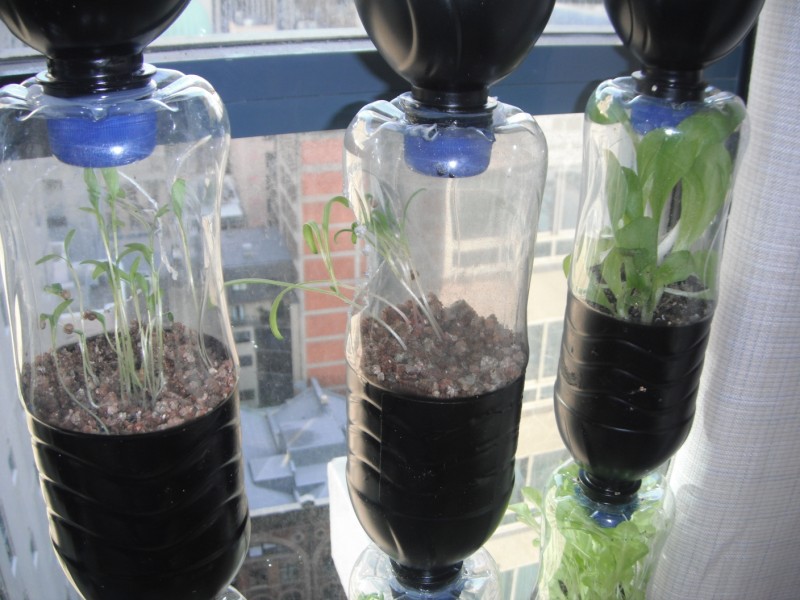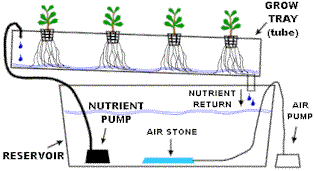Let’s face it, the world isn’t perfect. In a perfect world, we could have whatever food we wanted straight from the farm to our table. We would know what processes go into the growing of the food, and we’d know exactly what we were eating. And we could make sure it was healthy. It’s a dream that us urban farmers strive for. But, there is a darker side to this that we rarely acknowledge.
We also know from a nutritional standpoint that we need more variety than we can grow reasonably local under normal climate and weather conditions. Lettuces are tasty, but what about a slightly sweet jimcama? You might be able to grow oranges in your back yard, but kohlrabi that loves colder temperatures than your tropics can provide? And if you live in the Arctic Circle? It’s best to just grow them indoors all year round. Before you head to the grocery store, stop and ponder what the hardware store might have.
The Science of Hydroponics

Get the directions for this awesome set up on Urban Green Survival.
Hydroponics are one way to grow food out of their natural climate. The set up isn’t difficult to make, really. You can make something with a bit of scrap you have around the house like water bottles.
But, if you go the water bottle route, take note of the image to the right from Urban Green Survival: the spinach is growing straight up — and running out of space.
Still, the concept works with 20 ounce water bottles, surely you could scale it up to litre bottles and have more room for the lovely greens to grow.
Honestly, though, I prefer Trebuchet03’s Instructable on hydroponics on the cheap if I’m going to go that route. You see, he takes a Rubbermaid bin and transforms it into an ebb and flow variety of hydroponics tanks. Cost? $30.
The key features are the medium (substrate) that isn’t dirt, and have nutrient-infused water flowing around the roots to ensure the plants get enough food, water, and none of it stale.
Substrates
In hydroponics you plant the roots into a substrate that serves to hold the water and the nutrients closer to the roots for longer than the flash flood of your waterings. Not only does it save the plants stress, but it also saves you time and stress from watering them frequently. There are many things you can use from vermiculite to peat to coconut husks to floral foam. However, there do seem to be some favourites out there. According to 3Dponics, the four most popular substrates are lava rocks, expanded clay pebbles, coco coir (coconut husks), and peat moss. All of these are relatively easy to find, relatively inexpensive, and retain moisture well.

Simply Hydro has a lot of great layout ideas like these for a simple, yet sophisticated hydroponics setup.
Each have their pros and cons, so read up on the varieties before you settle on one. In fact, you should probably consider your entire set up, for one might be better than the other in a particular space with different lighting conditions and different water flow designs. For example, lava rocks are chemically inert, but they don’t hold water exceptionally well. This would be ideal for an ebb and flow system. On the other hand, coconut husks hold water better, but deteriorate after a season or two. This would be ideal if you are a seasonal grower or need to move soon.
Food
Plants need nutrients, and without the minerals in soil breaking down around the roots, they need to be fed regularly with a liquid solution you can add to the water. A friend of mine at Purdue did experiments with hydroponics both for their master’s thesis as well as for the love of it at home. They always bought their home supplies from a place called Planet Natural, and had good luck with them.
But, just like substrates, the type of food you get depends on the setup you want to have. Some plants do well with a small amount of liquid food added to the water as it drips through, while others can use a pellet that dissolves over time. The key is to find a food that works for the plant or plants you are growing.
Light
We’ve talked about the importance of lights many times, and it doesn’t change when you use hydroponics. In fact, the only additional care you might have is if you choose a clear container. If you do that, the sunlight beating in and nurturing your plants will dry out the substrate quicker, so you’ll have to water more frequently or check the flow of your setup to ensure no plants are drying out.
No matter what you do with hydroponics, the key is to start with research, open mind, and with a little bit of common sense you can’t go wrong.

